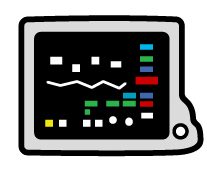
The screen near the patient’s bed is called a monitor. It displays information such as: heart rate, heart rhythm, blood pressure, oxygen and carbon dioxide levels. Sometimes it is used to monitor brain pressure. Devices from the patient's body send information to the monitor.
Some devices send information from body surfaces. Two common examples are:
Oxygen saturation device
This device clips onto a finger or an earlobe. It measures the oxygen levels in the blood.
Electrocardiogram (ECG)
Several electrodes are attached to the chest with stickers. These electrodes measure the rhythm and rate of the heart and sends the readings to the monitor.
Some devices attached to the monitor sending information from inside the body. Here are some examples:
Arterial line
This is a plastic tube inserted into an artery. The artery usually chosen for this is in the wrist, the neck or the groin. An arterial line measures the blood pressure with each beat of the heart. It also allows blood tests to be taken from a small tap.
Central venous catheter
This is a plastic tube inserted into a large vein to measure pressures. The vein usually chosen for this is in the neck.
Alarms will often be heard from monitors in ICU. It can be stressful hearing alarms if you are not used to them. Please know that staff are highly trained to know what to do for each alarm.
This topic was reviewed by an intensive care specialist in July 2022.